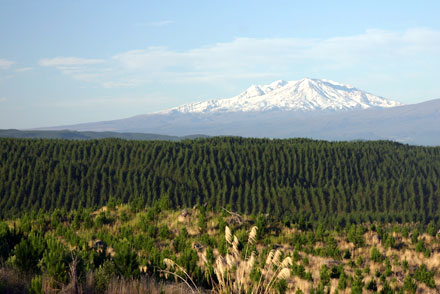
Increasing forestry harvests are expected to provide massive opportunities for the Bay of Plenty region in New Zealand. Source: The New Zealand Herald
Wood availability is forecast to increase rapidly leading into the 2020s in New Zealand with most of the increase from small-scale growers who established forests during the 1990s.
The supply of pinus radiata logs in the central North Island area, including Bay of Plenty, was expected to be 2 million cubic metres more in 2025 than in 2008, according to the Ministry of Agriculture and Fisheries’ forecasts.
Bay of Connections Forestry strategy head, Bryce Heard, said the central North Island area was New Zealand’s largest forest resource and had competitive advantages including climate, soils and access to geothermal energy.
He said forestry growth opportunities for the region included wood and wood fibre processing, as well as replanting.
Potential revenue growth from the sector was estimated at NZ$6 billion annually, with the majority of the increase coming from exports.
In recent years, there had been significant investment in the area’s processing capability.
Combined with strong international demand, particularly from Asia, the Bay of Plenty had the potential to compete internationally in processed wood product markets.
Mr Heard said the Bay of Plenty was focusing on improving market access for processed wood products by raising awareness of its uses and addressing barriers to export market development.
It was also helping Maori explore alternative land uses, including forestry and investment in the development of indigenous species plantations.
Associate Professor at the University of Canterbury School of Forestry, Dr Rien Visser, said trying to market the increased volume could be one concern.
New Zealand was very dependent on the Chinese market and it was hard to predict their needs. The sector was trying to develop the Indian market as an alternative.
Retrospectively, it wasn’t necessarily a good idea to plant such a large amount of forest at once in the 1990s.
“At the time there was obviously the perception that the world needed a whole lot more wood, but that’s never really panned out. So obviously we’re going to electronics a lot more and there simply isn’t always that very, very large demand for wood products,” he said.
“We’re dealing with the implications of that really sudden land use change. But conversely, what’s happening now is that we’re planting so few forests that we’ve actually got a massive decline in forested landscape. That’s going to come up as a real issue as well. We’ve gone from one extreme to the other.”
Scion Research principal scientist Dr Tim Payn said there would certainly be a peak in trees maturing but they didn’t have to be harvested in any one year.
People could work co-operatively to smooth out the wood flow. It was common for small growers to work co-operatively internationally and it was expected to become more common in New Zealand.





